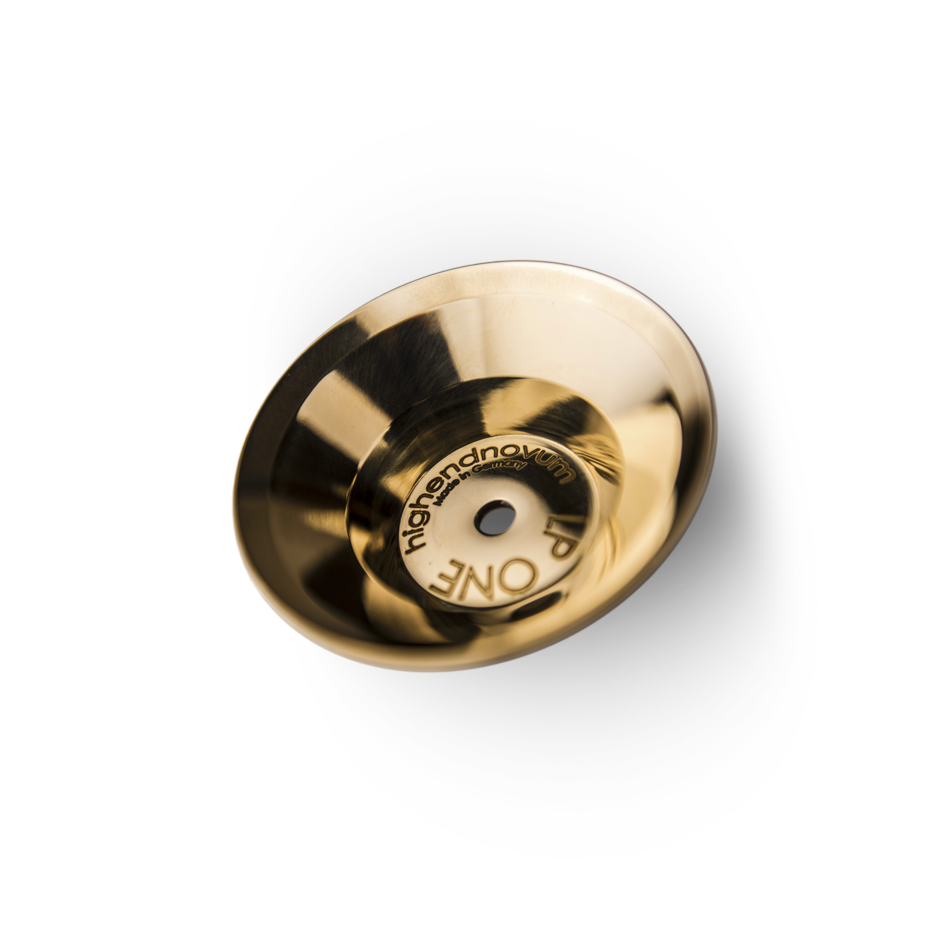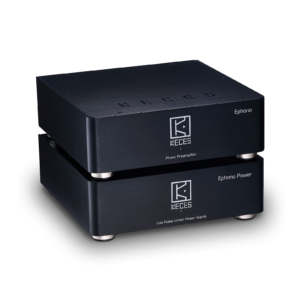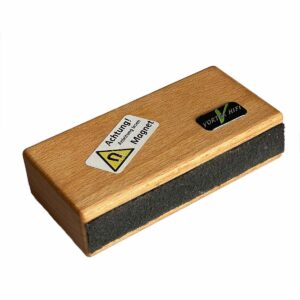High End Novum
PMR LP One
Resonating record puck
Incl. 21 % TAX € 490.00
- Vinyl record weight & resonator, following the same properties as the larger PMRs
- Made of a special bronze alloy
- Each LP One is individually and exclusively hand crafted in Germany
- Designed to guarantee a genuine reproduction of sound and music
- Color natural bronze
- Weigth 230 g
- Height 28 mm, diameter 44/89 mm
The Art of Sound
The Passive Multivocal Resonator (PMR) is a system which is highly vibratory, comprehending a broad spectrum of audio frequencies. It is designed to guarantee a genuine reproduction of sound and music.
Sometimes even high quality stereo systems are not able to fully reproduce music with all its vibes and liveliness. This leads to a listening experience which can hardly be called natural as it is merely a –somewhat soulless- copy of the musical information on a disc or LP. The problem of this lack of authenticity could be compared to a pixelated digital version of a master’s painting.
It is mainly the overtones which disappear when music is being recorded and reproduced the usual way. The loss of these overtones can not be fully compensated, even by installing expensive equipment or by modifying the stereo system’s acoustical environment.
This is where the PMR comes in: It is an acoustical instrument making it possible to complete the tonal spectrum of a piece of music by reflecting the important overtones. Friends of music from all over the world will be happy to discover a truly colourful and fine-tuned sound picture comprehending every single frequency of an instrument or voice. When listening to his favourite CDs/LPs, the PMR-user will recognise a more natural sounding record and it seems as if the music has got more space. Different voices, instruments and sounds in general are more distinguishable from each other. The PMR creates a deeply emotional listening experience.
Regarding its compatibility with stereo systems, basically all types of hi-fis can profit from a PMR – whether it completes a beginners’ equipment or a professional audiophiles’ setup. An important reason for the PMR being compatible with many stereos is the fact that it uses physical laws making it nearly independent from electric features.
The golden ratio adds tradition to the PMR
The geometry and design of the PMR are based on the so-called golden ratio. To give an example of this mathematical principle, it can be discovered in nature when it adds stability to the wings of a butterfly or supports a plants’ photosynthesis by defining the optimal arrangement of its leaves. In arts and architecture, the golden ratio has been a major contributor to many innovations. The principle, with its specific numerical proportions, was wellknown to Leonardo da Vinci, Raffael and Albrecht Dürer, to name only a few. When studying the architecture of the St. Peters’ Basilica in Rome, the medieval Notre-Dame cathedral in Paris, and many other ancient buildings, observers get the impression that the so-called sectio aurea was also known to their constructors – even to those of the pyramids at Giza.
Modern testing methods for a precisely calculated effect
However it is not only traditional knowledge which is used for the development of the PMR. The Resonator is also approved by the finite element method – a modern mathematical testing method providing solutions to complex questions in the field of solid-state physics. In fact, this method proved the PMRs theoretical principal of operation to be useful for the production of a fine-tuned resonator.
Another important aspect of the PMRs function is its unique material. A variety of metals as well as synthetic and natural materials was tested in order to find the ideal material for the PMR. In this process, one material appeared to be far above the other test objects: bronze which is normally used to cast church bells. The copper-tin-alloy of traditional bell bronze comprises harmonizing elements which are crucial for the optimal function of the PMR (as described earlier).
The comparative analysis of frequency responses makes it possible to detect fine distinctions surrounding the resonant frequency. This analysis shows that the PMR accurately arranges the whole frequency spectrum of loudspeakers and reflects them in a less elusive way. Moreover, measurements on its effects state the fact that the PMR is able to reproduce overtones far above 20 kilohertz. With the PMR, a more balanced sound radiation can be seen in the important range between 200 and 3000 hertz. Through various geometrical testing methods, the PMR’s excellent spatial reproduction of the music can be explained.
PMR as an emotional listening experience
Considering the results of the metrological control only, the changes caused by the PMR are moderate – however the audible changes continue to fascinate even experienced ‘Audiophiles’. The differences might even be described with the sound of a Stradivarius violin compared to a usual violin: metrological control procedures can not explain the difference between these instruments but concert-goers will surely find many words to describe the excellent listening experience.
As a handmade product, every PMR is extensively ’prelistened’ to and manually processed so as to create a resonator whose acoustical behaviour can meet the metrological requirements. This time-consuming process is necessary to ensure that every PMR works identically when installed in different environments.
The Passive Multivocal Resonator is the discerning listeners’ access to new and exciting soundscapes which can even be experienced at home, lending the sounds liveliness as never heard before.
Reviews:
LP One von HighEndNovum von Regina Wegers und Marco Kolks@Hoererlebnis.de
Highend Novum LP One@Stereo Magazine
PMR LP One by Thomas Schmidt@LP Magazine
| Gewicht | 0.23 kg |
|---|
Wees de eerste om “High End Novum
PMR LP One
Resonating record puck” te beoordelen Reactie annuleren
Gerelateerde producten
Incl. 21 % TAX € 1,899.00
Incl. 21 % TAX € 599.00
Incl. 21 % TAX € 1,150.00











Beoordelingen
Er zijn nog geen beoordelingen.